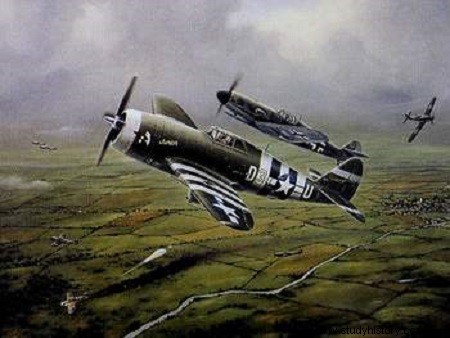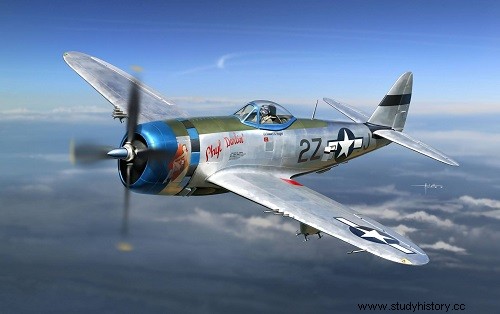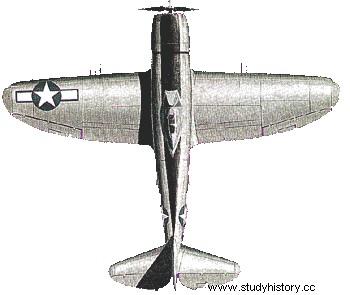
Like the North American P-51 Mustang, the Thunderbolt was designed entirely and built during the war years. In fact, it was the logical conclusion of a series of fighters created by Républic and characterized by their barrel fuselage, a series which had begun in the 1930s with the P-35 and which had led to the P-43 Lancer of 1940.
The first two aircraft designated P-47 actually looked very little like the future Thunderbolt because they had been designed in response to USAAF requests for a light fighter. These two planes were the XP-47, equipped with an Allison V-1710-39 inline engine and two 12.7 mm machine guns, and the XP-47A, a simplified version of the previous one. Despite the USAAF's interest in these two projects, reports following the fighting in Europe led officials to the conclusion that they should consider re-equipping American fighter groups with aircraft whose speed would exceed the 640 km/h of the XP-47 and XP-47A. These aircraft also required much greater armament, armor protection and self-sealing fuel tanks. In possession of the new specifications, the Republic design office, under the direction of Alexandre Kartveli, undertook a complete overhaul of the initial project from which the XP-47B emerged. This aircraft was powered by a Pratt and Whitney R-2800 Twin Wasp radial engine and nothing was sacrificed, performance or combat ability, to the reduction in overall weight. On the contrary, the planned armament, consisting of eight 12.7 mm machine guns, was well above the standards of the time. Despite the estimated total weight of around 5,400 kg, which was to make it the heaviest fighter ever produced to date, the USAAF ordered Republic to continue building a prototype in September 1940 .
The design of the new fighter was based entirely on its bulky radial engine and its turbo-chargers. Kartveli undertook to solve the problem of the positioning of the first, then established the fuselage according to the mechanical assembly constituted by these two major elements. In order to balance the aircraft, the supercharging installation was placed at the rear of the fuselage. This arrangement required air to be taken from the front, led to the compressor and then directed back to the engine while the exhaust gases which drove the turbo-compressor were evacuated to the rear where, after having worked, they were ejected under the fuselage.
Deliveries of the P-47Bs, which differed from the prototype by their sliding canopy, instead of a tilting canopy, and their R-2800-21 engine , began in 1942, and 171 aircraft bearing this designation were built. The P-47B began operational service over Europe, and combat experience against German fighters in April and May 1943 demonstrated that, despite the relative lack of maneuverability and insufficient rate of climb, its weight favored fantastic dives and its structure was susceptible to damage that would have totally destroyed any other fighter.
Production of the 602 P-47Cs which constituted the balance of the initial order began during the last quarter of 1942. These aircraft received a drop tank attachment under the fuselage which was, moreover, lengthened by 32 cm to improve control. The additional tank increased the range from 880 to 2,000 km, and the installation of a 2,300 horsepower R-2800-59 engine considerably increased the rate of climb of the P-47C as well as its overall performance.
This last engine, giving an overpowered 2,535 horsepower with water injection, if necessary, was fitted to later aircraft, of the P-47D series. This model, which was built in greater numbers than all the other types of aircraft (12,608 copies), also received under each wing a
pylon for attaching additional tanks which gave it a range of 2,900 km.

A bubble canopy was introduced on the later P-47Ds. This equipment had been tested, in place of the previous cockpit, as well as a lowered rear fuselage on the XP-47K which remained unique. The improved field of vision provided by this canopy proved to be very useful in combat. The last examples of the P-47D also received the R-2800-63 engine and wing attachments allowing the attachment of 10 5-inch (12.7 cm) rockets which further increased the firepower of the Thunderbolt in its version fighter-bomber. The Curtiss-Wright firm also built 354 P-47Ds, under the designation P-47G.
Towards the end of 1944, the arrival of new German fighters and the threat of V-1 flying bombs led to the study of the P-47M. Designed as a pure fighter, all bombing and assault equipment was removed from the 130 units built. Power was provided by a thrust R-2800-57 engine, which gave 2,800 horsepower at 10,000 meters.
The last production Thunderbolt was designed for use in Pacific theaters of operations, where range was a particularly important factor. The P-47N had to meet this characteristic:identical to the P-47M, its wingspan was increased by 56 cm to reach 12.97 meters. The engine was a 2,800 horsepower R-2800-77, and the increased tank capacity gave the P-47N the longest range of any Thunderbolt built, at 3,780 km. The fighter-bombing equipment was reinstalled, while the dorsal ridge was enlarged compared to that of the P-47Ds. P-47N production rose to 1,816 before the end of the war with Japan led to the cancellation of orders for 5,934 more Thunderbolts. The production of this aircraft, all types combined, reached 15,683 aircraft.
dates
commissioning date :1942
date of end of use :1966
Number built 15,683
Nationalities
Constructor :USA
Users :USA, France, United Kingdom, Peru, Brazil, USSR, Australia...

Categories Fighter Bomber

Technical and Performance Data
Wingspan :12.43m
Length :11.07
Height :4050
Weight :4,728 kg
Maximum weight :7031
Surface :28.61m2
Autonomy :900 km
Maximum speed :760km/h
Ascending Speed :1067m/min or 9900m in 13 minutes 14’’
Practical ceiling :12500m
Cruising speed :480km/h
Motorization (motors or reactors) :- 1 pratt&whitney in R-2800-57 Double Wasp with 18 star cylinders of 2800ch

Armaments :8 x 12.7mm machine guns
External 1,135 kg of bombs or 10 x 127 mm rockets or 2 x 450 bombs and 6 x 144 mm rockets
